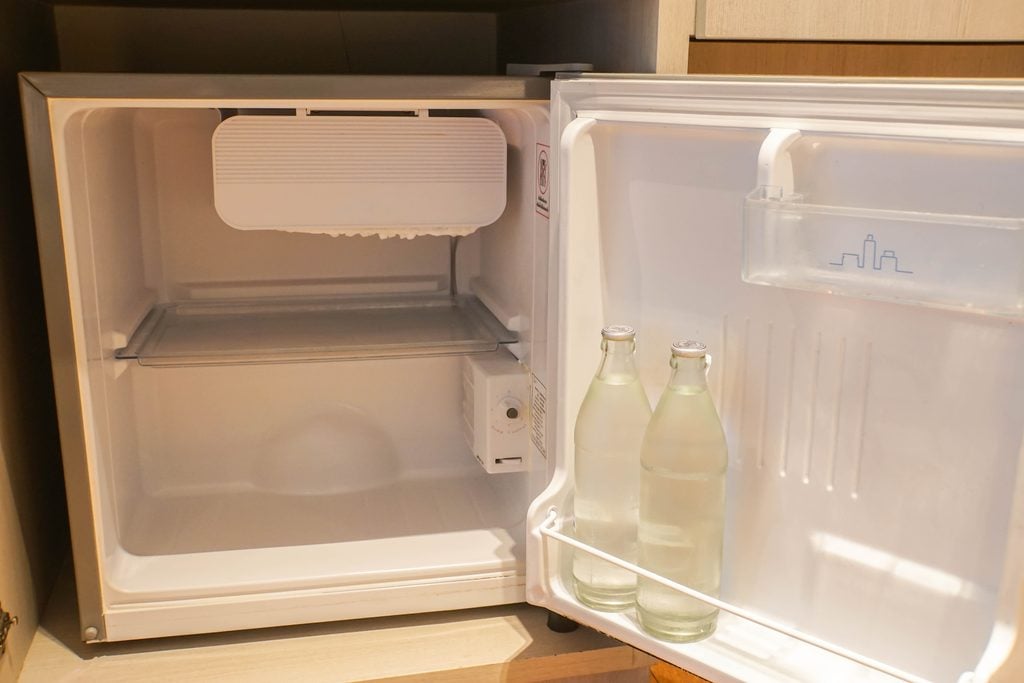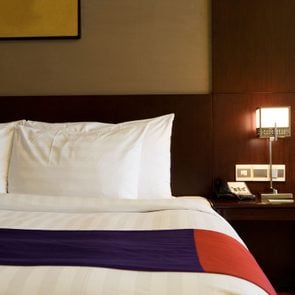Why Hotels Are Starting to Get Rid of Minibars
Updated: Jul. 15, 2021
Minibars were a sweeping success when they were first introduced in the 1970s. But the travel industry has changed quite a bit since then.
Hotel minibars are a feature that people seem to either love or hate. They definitely serve a useful purpose—they’re convenient for when you’re hanging out in your room and want a snack or a drink. On the other hand, though, they’re expensive. Notoriously so, and even laughably so. Who could forget the infamous scene in the Las Vegas episode of Friends where Rachel takes macadamia nuts from the minibar in Ross’s hotel room and spits them out without eating them, to get back at him for pranking her?
But their infamy is a testament to what a staple of the hotel experience, at least in reasonably up-scale hotels, they have been since their mainstream debut in Hong Kong in 1974. So…why, in the past few years, have they seemed to be vanishing? And they’re not alone: These other amenities have been vanishing from hotels as well.
They’re not profitable
That Hilton hotel in Hong Kong reportedly saw a whopping 500 percent increase in in-room drink sales when they introduced minibars. The logic was there: why would you want to go elsewhere to get refreshments when you could just stroll across your hotel room? Indulgence—perhaps overindulgence—in hotel minibars by the uber-wealthy became synonymous with the luxurious American hotel experience.
But the comically high prices—eight dollars for a single soda can, four for a candy bar, and the like—have taken a toll. Back when minibars were the Next Big Thing, people might pay those high prices for the thrill and luxurious feeling it brought. But the fact that they cater to such a small sector of hotel-goers hasn’t helped them through the years. In recent years, minibars have not been profitable—far from it. In 2017, a CBRE Hotels report found that minibars accounted for a mere 0.4 percent of the revenue generated by food and beverages.
CNN Travel also reports that minibars are costly for hotels to maintain, and can cause undue frustration for hotel employees and guests alike. Jurga Rubinovaite, travel blogger and author of Full Suitcase, agrees: “There is always a chance of a human error or guests’ dishonesty, and it’s really hard for the hotels or the guests to prove who is right,” she told Reader’s Digest. “Even the sophisticated sensors can lead to unfair charges if the guest just replaced an item or used the fridge to store their own food and drinks.” So from a business perspective, it’s no surprise that they’re disappearing.
Options are changing
While minibars are nice because of how accessible the snacks are, many travelers on the more frugal side don’t find the high prices to be worth the convenience. “More and more people prefer to walk to a nearby convenience store or get a drink at the bar instead of paying for minibar consumptions,” Rubinovaite explains. (And, of course, many hotels have convenience stores on property, so that they can still profit from this trend.) According to Cvent, some hotels have also embraced this by keeping the minibars themselves, but emptying them, so that hotel guests can use them to store their own snacks.
But primarily, the hotel landscape as a whole is changing. “Hotels are moving towards offering services and amenities that focus on creating a sense of community on property,” explains Angie Rice, co-founder of Boutique Travel Advisors. “In lieu of the minibar in rooms, hotels are providing an inviting happy hour scene to their guests in lobbies and lounges with complimentary food, beverages, music, and other entertainment.” PFK Hospitality Research has tracked this change, finding that from 2007 to 2012, a period when overall minibar revenue fell a full 28 percent, the revenue from hotel bars and lounges grew 4.9 percent. Hotels’ increased focus on creating a sense of community is just one of the ways travel is changing in 2020.
Is there still a place for minibars?
Rice says that plenty of hotels are keeping minibars around to cater to a specific clientele. “Some hotels that continue to stock minibars are using this service to reward their loyalty members,” she says. “They are offering credits anywhere from $10 per stay to as much as $50 daily to their highest-tier members.” So minibars may not be going the way of these things you’ll never see in hotels again just yet, but your future hotel rooms might be less and less likely to have one.




